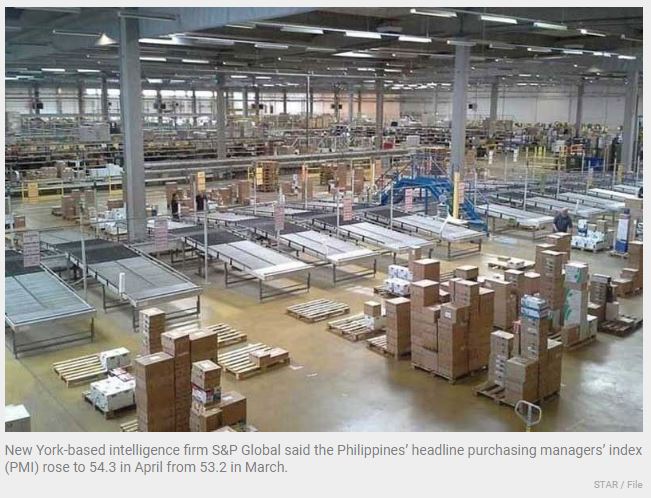Philippines: Factory output hits 4-year high
MANILA, Philippines — The Philippine manufacturing sector continued to bounce back in April, hitting the highest rate for more than four years as conditions improved with declining COVID cases and lifting of restrictions.
New York-based intelligence firm S&P Global said the Philippines’ headline purchasing managers’ index (PMI) rose to 54.3 in April from 53.2 in March.
The latest reading registered above the threshold that separates expansion from contraction for three straight months now.
The April print was also the strongest in over four years or since November 2017, which S&P said pointed to a solid improvement in overall operating conditions.
Last month, a majority of provinces in the country remained under Alert Level 1 or the most lenient pandemic alert classification as new COVID cases continued to decline.
The headline PMI provides a quick overview of the health of the manufacturing sector based on the weighted average of five indicators: new orders (30 percent weight), output (25 percent), job creation (20 percent), supplier delivery times (15 percent) and inventories (10 percent).
S&P Global, which recently completed its merger with PMI compiler IHS Markit, said the country has shown further signs of recovery from the latest Omicron wave in January, as evident in the April PMI data.
“Looser pandemic restrictions led to a stronger improvement in operating conditions across the manufacturing sector in the Philippines at the start of the second quarter,” S&P Global economist Maryam Baluch said.
However, Baluch said global headwinds, especially from the war between Ukraine and Russia, have led to further pressure on supply chains.
“While strengthening client demand has been able to support the recovery so far, it will be important to see how growth momentum is sustained amid ongoing supply chain disruption and sharply rising costs,” she said.
The PMI showed that both output and new orders on the domestic front expanded for the third straight month, as looser pandemic restrictions supported the latest upturns in customer demand and production schedules.
International export orders, however, declined for the second month, hampered by the war, higher shipping costs and limitations still due to the pandemic.
Baluch emphasized that geopolitical tensions continue to add to the ongoing strain on the supply side. She said raw material shortages and shipment delays led to a further lengthening of average suppliers’ delivery times.
Further, improving customer demand and rising production requirements led to another increase in buying activity, the fastest in three years. Firms also increased their holdings of raw materials and semi-finished items.
On the other hand, the April PMI pointed to a stabilization of workforce numbers across the local manufacturing sector.
Improving economic activity resulted in no change in employment in the latest survey period, thereby ending a 25-month period of job shedding.
“However, reports of worker resignations were widespread, often due to the pandemic, which weighed on companies’ abilities to expand staff numbers overall,” Baluch said.
Amid material scarcity, rising fuel and energy costs and supplier price increases point to marked inflationary pressures across the country’s manufacturing sector.
Overall, input costs just slightly eased from the record-high in March, which still resulted in another sharp increase in selling prices.
Moving forward, firms remained positive on the outlook for the rest of the year, improving to a four-month high in April.
“Weaker COVID containment measures underpinned forecasts of stronger demand conditions and rising output in the coming months,” Baluch said.
Source: https://www.philstar.com/business/2022/05/03/2178289/factory-output-hits-4-year-high


 Thailand
Thailand




